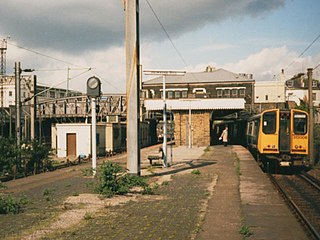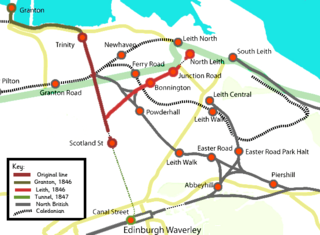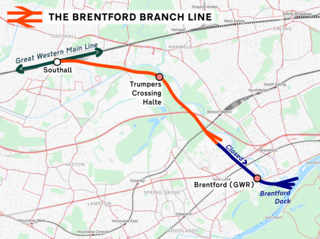Coordinates: 38°10′15″S145°58′5″E / 38.17083°S 145.96806°E References
- ↑ "Nilma | Victorian Places". www.victorianplaces.com.au. Retrieved 23 September 2018.
Nilma is a closed station on the Orbost railway line in the town of the same name in Victoria, Australia. It was originally named Bloomfield but was changed to Nilma in 1909, due to confusion with Broomfield railway station near Creswick, on the Ballarat to Daylesford railway line. Nilma station was closed in 1951. [1]

The Chūō Main Line, commonly called the Chūō Line, is one of the major trunk railway lines in Japan. It connects Tokyo and Nagoya, although it is the slowest direct railway connection between the two cities; the coastal Tōkaidō Main Line is slightly faster, and the Tōkaidō Shinkansen is currently the fastest rail link between the cities.

Waddesdon is a closed station that served the village of Waddesdon and its manor, to the north of Aylesbury in Buckinghamshire, England. The station is not to be confused with Waddesdon Road railway station at the other end of the Waddesdon Manor estate on the Brill Tramway.

The Hokuriku Main Line is a 176.6-kilometer (109.7 mi) railway line owned by the West Japan Railway Company connecting Maibara Station in Maibara, Shiga, with Naoetsu Station in Joetsu, Niigata. The section between Kanazawa Station and Naoetsu Station is now operated by third-sector railways. It serves the Hokuriku region on the northern central coast of Honshu, the largest island of Japan, as well as offering connections to the regions of Kansai, Tōkai, Kantō, and Tōhoku.
Nilma is a locality in the West Gippsland region of Victoria, Australia located between Warragul and Darnum.
Wood Lane was a station on the London Underground that was located in Shepherd's Bush, west London. It was opened in 1908 on the Hammersmith branch of the Metropolitan Railway, on the viaduct adjacent to the bridge over Wood Lane and close to a station of the same name but on the Central London Railway.

Primrose Hill was a railway station in Chalk Farm, in the London Borough of Camden, opened by the North London Railway as Hampstead Road in 1855. It was named Chalk Farm from 1862 until 1950, when it was given its final name. From the 1860s to 1915, it was linked with a formerly separate station opened by the London and North Western Railway in 1852. The station closed in 1992, and the platform buildings and canopies were removed in 2008.

The Calder Valley line is a railway route in Northern England between the cities of Leeds and Manchester as well as the seaside resort of Blackpool. It is the slower of the two main rail routes between Leeds and Manchester, and the northernmost of the three main trans-Pennine routes.

The Hallam Line is a railway connecting Leeds and Sheffield via Castleford in the West Yorkshire Metro area of northern England. It is a slower route from Leeds to Sheffield than the Wakefield line. Services on this line are operated by Northern Trains. Services from Leeds to Nottingham also use the line.

The Penistone Line is operated by Northern Trains in the West Yorkshire Metro and Travel South Yorkshire areas of northern England. It connects Huddersfield and Sheffield via Penistone and Barnsley, serving many rural communities. Metrocards can be used for travel between Huddersfield and Denby Dale and intermediate stations.
The Wakefield line is a railway line and service in the West Yorkshire Metro and South Yorkshire Passenger Transport Executive areas of northern England. The Wakefield line is coloured yellow on maps and publications by West Yorkshire Metro. The line was electrified in 1989, between Leeds & Wakefield Westgate, as part of the programme to electrify the East Coast Main Line.

The Varsity Line was the main railway line that linked the English university cities of Oxford and Cambridge, operated by the London and North Western Railway.

Peterborough railway station serves the city of Peterborough, Cambridgeshire, England. It is 76 miles 29 chains (122.9 km) down the East Coast Main Line from London King's Cross. The station is a major interchange serving both the north–south ECML, as well as long-distance and local east–west services. The station is managed by London North Eastern Railway. Ticket gates came into use at the station in 2012.

Euxton Balshaw Lane is one of two railway stations situated in Euxton, Lancashire, England. It is a local station on the West Coast Main Line on the stretch between Wigan and Preston.

Brownhills railway station is a disused railway station that served the town of Brownhills and the village of Clayhanger in the Metropolitan Borough of Walsall, West Midlands. It was on the South Staffordshire Line between Walsall and Lichfield.
There are 22 disused railway stations in the 75 miles (121 km) between Bristol Temple Meads and Exeter St Davids, 12 of which have structures that can still be seen from passing trains. Most were closed in the 1960s but four of them, especially around Weston-super-Mare, were replaced by stations on new sites. 13 stations remain open on the line today, but there have been proposals to reopen stations at Cullompton and Wellington.
Brownhills Watling Street railway station was a station on the Midland Railway in England. It was opened in 1884, closed in March 1930 for passenger use and the track was closed in 1960.

The Edinburgh, Leith and Newhaven Railway was a railway company formed in 1836 to connect the city of Edinburgh with the harbours on the Firth of Forth. When the line connected to Granton, the company name was changed to the Edinburgh, Leith and Granton Railway. It opened part of its route in 1846, but reaching the centre of Edinburgh involved the difficult construction of a long tunnel; this was opened in 1847. It was on a steep incline and was worked by rope haulage.

The Brentford branch line, also known as the Brentford Dock Line, is a freight-only branch railway line in west London, England. The route, which opened in 1859, was backed by the Great Western Railway and built by the Great Western & Brentford Railway Company. It ran 4 mi (6.4 km) from Southall to Brentford Dock. In 1964, the line to the wharves was closed. The branch now runs from the Great Western Main Line to a goods yard and waste transfer station in Brentford.

The San'yō Main Line is a major railway line owned by JR Group companies in western Japan, connecting Kōbe Station and Moji Station, largely paralleling the coast of the Inland Sea, in other words, the southern coast of western Honshu. The San'yō Shinkansen line largely parallels its route. The name Sanyō derived from the ancient region and highway San'yōdō, the road on the sunny (south) side of the mountains.